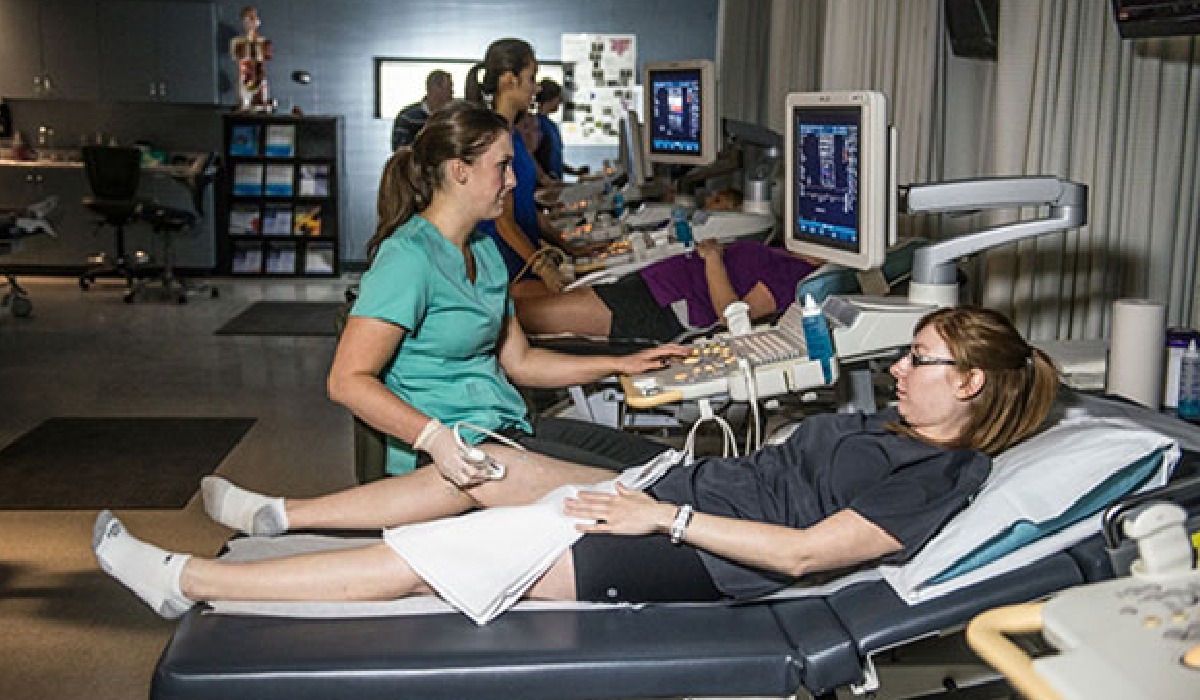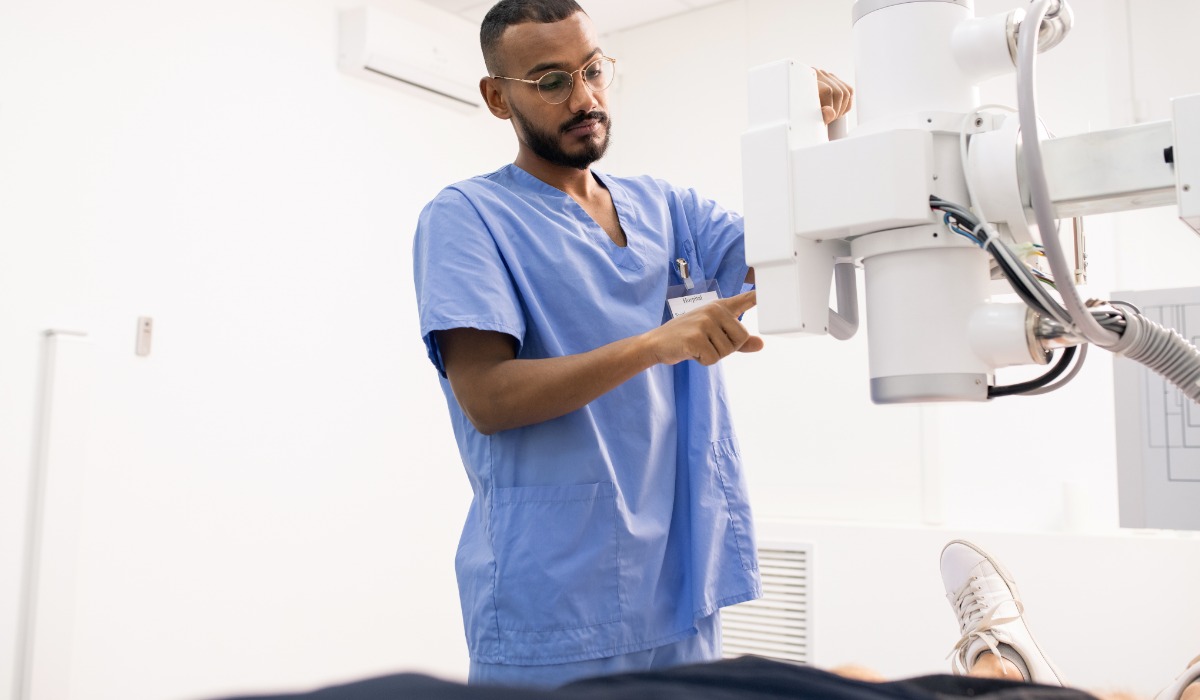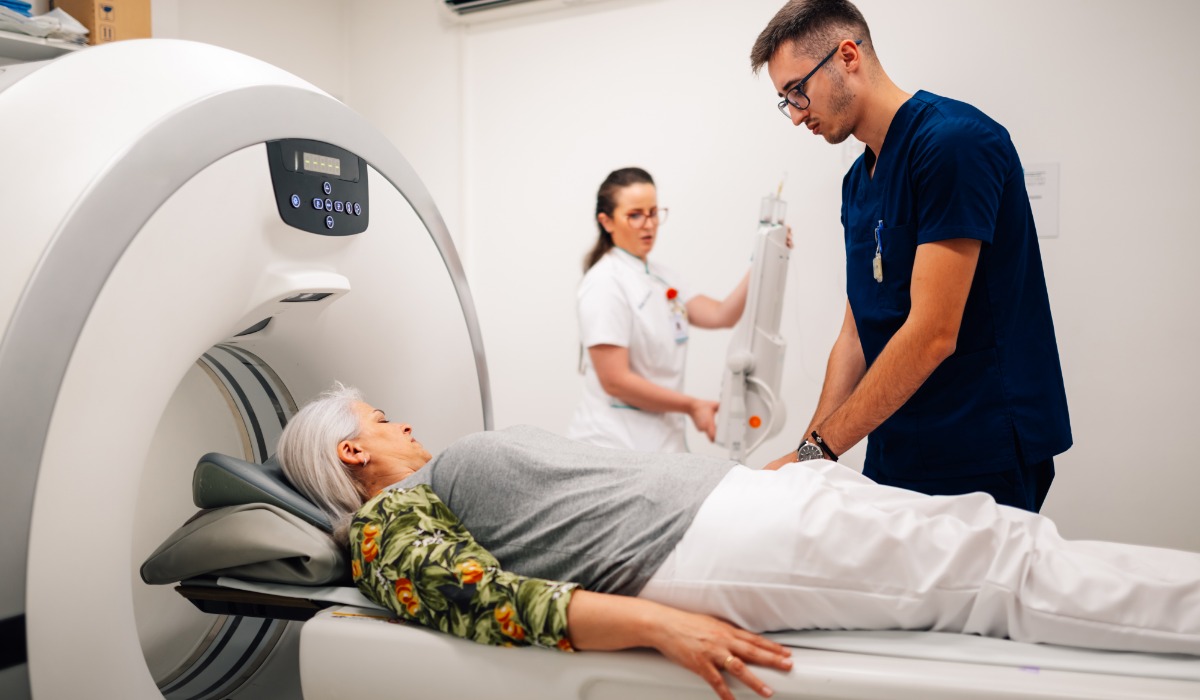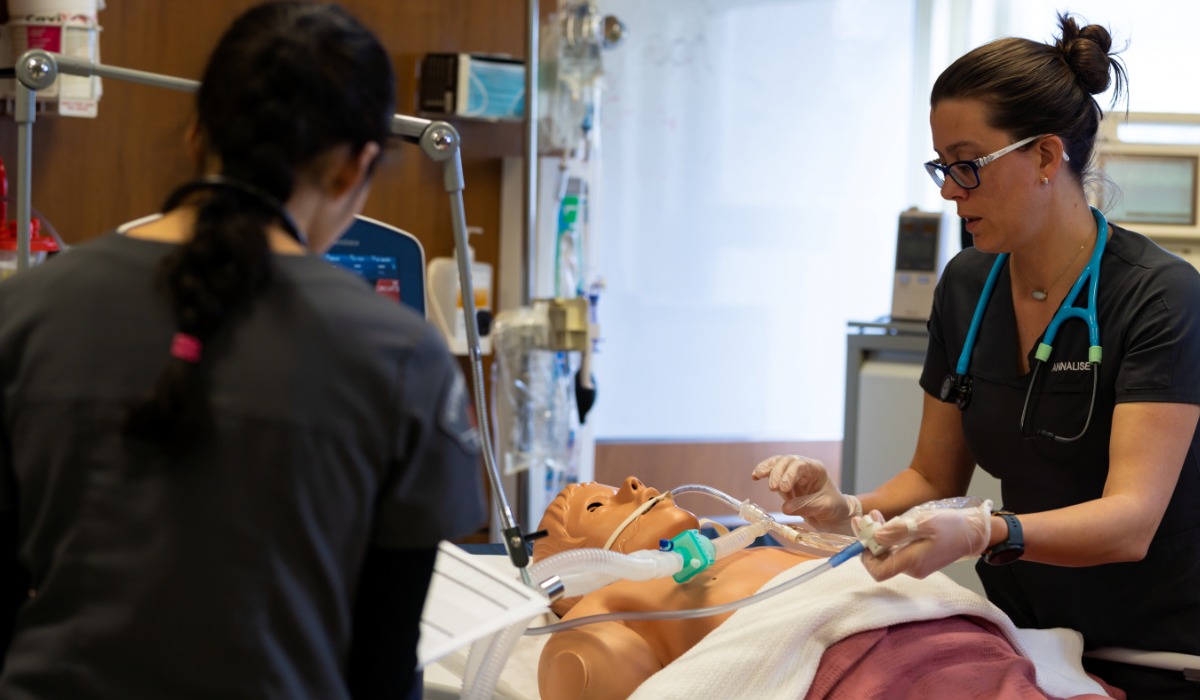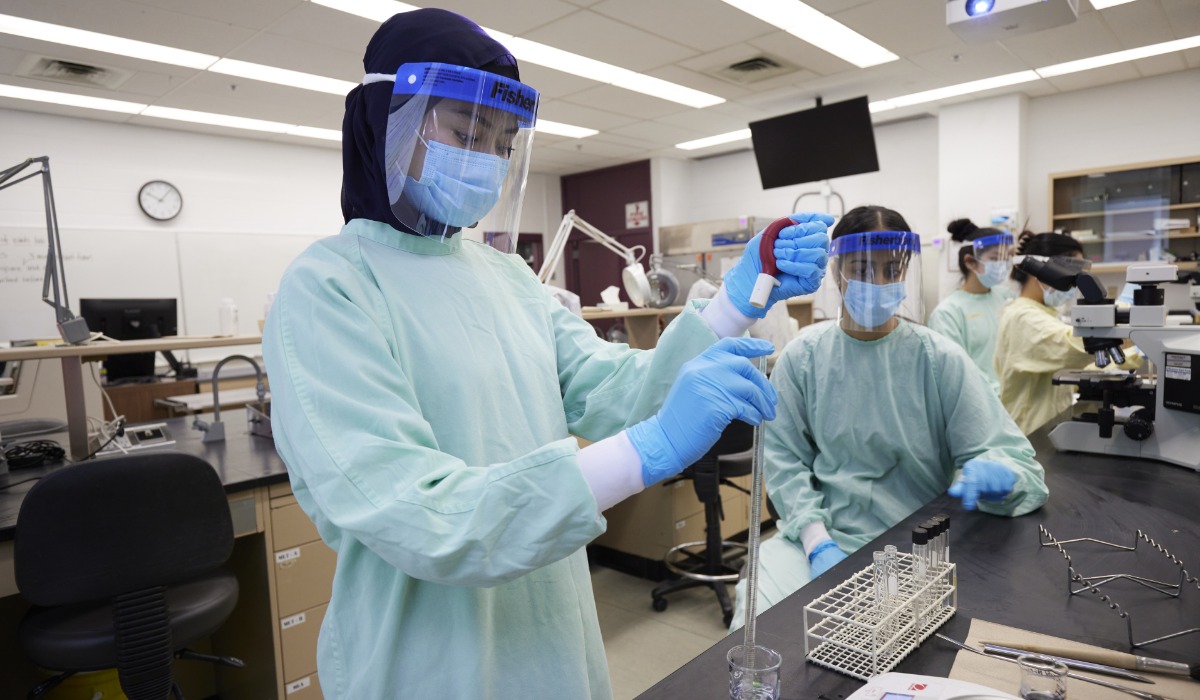Mandatory requirements
Applicants for this program are required to complete the School of Health and Public Safety entrance testing process as an admission requirement for this program by the set deadlines. Review admission requirements for more details.
Overview
The Diagnostic Medical Sonography program provides comprehensive knowledge and practice in ultrasound technology, a critical component of modern healthcare diagnostics.
It will equip you with the technical expertise and interpersonal skills necessary to assess and evaluate body organs and structures, which will assist physicians in the medical diagnosis and ongoing health management of patients.
In this program, you will:
- learn the science behind high-frequency sound waves and their application in sonography and the instrumentation that produces ultrasound images
- assess and image fetal and gynecologic structures, the intricacies of the heart and the body's circulatory system (arteries and veins), the abdominal cavity, focusing on organs such as the liver, kidneys and pancreas, and superficial tissues, including the thyroid gland and breast tissue
- develop skills to provide quality patient care, from bedside manner to handling sensitive situations
- get an in-depth understanding of the human body's structure and function to enhance imaging
- learn to participate in medical research and maintain high standards of quality control in imaging
- master the performance of various ultrasound scanning procedures with precision and care
You will get hands-on training and practical learning experiences in labs and workplace settings, covering sonography theory and techniques within clinical practice in patient care teams and enhancing the collaborative skills vital in healthcare.
Upon graduation, you will be prepared for a fulfilling career in diagnostic medical sonography in hospitals and community clinics.
If you seek a career combining technology with direct patient care, are detail-oriented, enjoy working with advanced technology, and have strong communication skills, this program will prepare you to enter the workforce as a diagnostic medical sonographer, making a difference in the lives of patients every day.
Those in diagnostic medical sonography tend to be objective, methodical and innovative.
You need:
- good health and upper body and shoulder strength
- physical dexterity to be able to use your hand, wrist, and arm for prolonged periods
- strong hand-eye coordination
- communication and observation skills
- the ability to visualize in three dimensions
- extensive knowledge of anatomy and physiology
- to be comfortable with human blood and tissue
- attention to detail
- critical thinking skills
- perseverance
- the ability to handle unpleasant situations and work under pressure
- teamwork skills
- to adhere to a high standard of medical ethics at all times
You should enjoy working with all types of people, using technical equipment and compiling information.
As a diagnostic medical sonographer, you may work in environments where a considerable amount of time is spent standing or sitting while performing tasks that may be repetitive. You should observe safety precautions and ergonomics to reduce the risk of exposure and injury. Individuals with previous chronic or repetitive strain injuries have experienced re-injury or aggravation of these conditions in this program or as a sonographer.
All medical personnel should be comfortable assessing injuries, performing patient care procedures which may be sensitive, and wearing personal protective equipment (PPE) for extended periods. This includes exposure to latex and other disinfectant materials.
You are strongly encouraged to refer to the ALIS website for career, learning, and employment information for diagnostic medical sonographers to ensure you can successfully meet the occupational requirements for the program and profession.
You will complete required clinical practicums and rotate through different settings to achieve specific clinical objectives.
By completing all practicum rotations, you will specialize in Generalist Sonography. In addition, you will complete a practicum pathway, in which you'll specialize in either Adult Echocardiography or Vascular Sonography. You will be assigned your pathway selection before your first practicum.
You will practice all competencies associated with the practicum pathway you are assigned, though these competencies may not fully align with those detailed in your course outlines. Additionally, each competency associated with your practicum pathway will not necessarily be practiced consistently in all of your practicum rotations.
You will be assigned practicum placements with consideration given to your preference of location. However, due to limited availability in Calgary, it might be necessary for you to travel or relocate outside the city.
The healthcare field has a strong focus on health, wellness, and fitness to practice due to the demanding nature of the work and Occupational Health and Safety requirements. As such, special considerations will not be granted based on individual circumstances or preferences, except those stated as protected grounds when an accommodation has been approved.
In compliance with the practica agreements with our clinical partners, you will be required to provide specific documentation before you can participate in your practicum. Find out what requirements you need for this program.
Some seats in each intake of this program are reserved for applicants currently residing in Saskatchewan via our interprovincial health training agreements.
This program is accredited by Accreditation Canada, and works closely with our Diagnostic Imaging Advisory Committee to ensure our curriculum continues to meet or exceed provincial and national accreditation standards.
Graduates of this program are eligible to write the Sonography Canada registry exams in:
- Core (Physics), and
- Generalist, and
- Adult Echocardiography or Vascular, depending on the practicum pathway graduates completed within the program.
In addition, graduates are eligible to write the American Registry of Diagnostic Medical Sonography exams.
Upon successful completion of this program, you'll be awarded a SAIT Diagnostic Medical Sonography diploma.
Careers and opportunities
Each year, SAIT conducts a survey between February and April to determine the employment rate, salary and satisfaction of our newest SAIT alumni.
![]() 100% graduate employment rate
100% graduate employment rate
![]() $85,498 average starting salary
$85,498 average starting salary
Find out more about our graduate employment statistics >
Our graduates may work in the following occupations. Some careers require additional experience and education.
Associated National Occupational Classification (NOC) codes: 32122.
Career planning support
Unsure which career path is for you? Here are some recommended career planning resources to help you decide your future.
You can also head to Alberta alis for lots of information about careers in Alberta, including quizzes and labour market information to help you narrow down a path.
Finally, you can take our online career finder quiz, which can help narrow your options based on your current skills and interests.
Courses
The Diagnostic Medical Sonography diploma requires 79.5 credits (27 courses) to complete.
The program spans 2.5 years, with seven semesters.
ℹ️ This program has been redesigned, effective for new student intakes beginning in the 2026/27 academic year (intakes beginning July 2026 or after). The required courses have changed; however, the program structure and total required credits have not. The required courses listed here are effective for all intakes before July 2026.
| Course | Credits |
|---|---|
|
Sectional Anatomy is the study of human anatomy in two-dimensions along multiple planes. Learners will use anatomical cross-sectional slices to investigate spatial relationships between anatomical structures in the body. Focus will be placed on identifying normal anatomy and spatial relationships of organs and structures specific to ultrasound studies. |
3 |
|
This course provides an overview of the basic anatomy and physiology of the human body. While focusing on the functions, structures and processes of the different body systems you will learn about anatomical positions, cells, muscle fibers, bones and joints, the spinal cord, sensory receptors, hormones, the major organs and digestion. Other topics covered in this course include healing, immunity, aging, the body's adaptive responses to sickness and disease, the menstrual cycle, and reproduction. |
3 |
|
This course provides an introduction to ultrasound principles, instrumentation, and imaging techniques utilized in a diagnostic medical sonography lab. The learner will develop the basic skills of scanning that are necessary for the DMS lab courses and practical rotations. |
1.5 |
|
Professional Practice 1 focuses on developing professional behaviour in a diagnostic imaging context. Lectures, classroom interactions and laboratory experiences are combined to demonstrate the skills required to ensure appropriate workplace relations, patient care, and to prepare learners for practicum. Equivalents:
|
3 |
|
Obstetrics and Gynecology Sonography 1 will review the anatomical components and related physiology of the female reproductive system, the pregnant uterus, and the embryo/fetus as they pertain to medical sonography. The principles and techniques of gynecological and obstetrical sonography will be introduced and accompanied by ultrasound scanning of the female pelvis in a lab setting. The recognition of normal gynecological and obstetrical sonograms will be covered in a classroom setting and reinforced in a lab setting. Pre-requisites:
|
3 |
|
Adult Echocardiography 1 reviews cardiac anatomy, cardiac physiology and hemodynamics. Combined with established theory, hands-on lab applications will be used to demonstrate correct scanning techniques and introduce proper interpretation and assessment of echocardiographic images. Pre-requisites:
|
3 |
|
Abdomen and Superficial Structures 1 provides a comprehensive assessment of structures in the abdominopelvic cavity focusing on normal anatomy, physiological processes, common sonographic presentations and an introduction to the fundamentals of pathological processes. The recognition of normal sonographic findings will be reinforced in a lab setting. Pre-requisites:
Equivalents:
|
3 |
|
Vascular Sonography 1 will provide a review of the anatomy and physiology of the vascular system and related hemodynamics as they pertain to vascular sonography. Pathologies of the venous vascular system as well as the principles and techniques of vascular sonography are introduced and accompanied by ultrasound scanning sessions in a lab setting. The recognition of normal sonographic findings in vascular sonography will be emphasized and reinforced in a lab setting. Pre-requisites:
|
3 |
|
This course focuses on preparing learners for entry into clinical practicum. Lectures, on-line discussion, and classroom interactions are combined to convey the expectations and requirements for learners in their clinical practical. Pre-requisites:
|
1.5 |
|
This course continues to focus on cardiac Doppler principles, cardiac Doppler imaging, and covers common pathologies such as valvular disease and heart failure seen in adult echocardiography. Pathologies will be discussed with a focus on the description of the disease, its clinical presentation, its typical and atypical sonographic appearance(s), its hemodynamic significance, the differential diagnosis or diagnoses involved, and the optimum scanning techniques in imaging the abnormality and its associated findings. The learning in this course is further refined by students' hands-on laboratory and clinical practicum experiences in clinical settings where echocardiography is performed. Pre-requisites:
|
1.5 |
|
Obstetrics and Gynecology Sonography 2 covers common maternal diseases as well as intrapartum and postpartum events and conditions. The effects of these conditions on the fetus and the fetal environment will discussed. Recognition of these conditions will be covered in a classroom setting and reinforced in a lab setting. Pre-requisites:
|
1.5 |
|
Vascular Sonography 2 provides theory of anatomy and hemodynamics and the ultrasound assessment of the carotid arteries and intercranial vessels. The recognition of normal sonographic findings in vascular sonography will be reinforced in a lab setting. Pre-requisites:
|
1.5 |
|
This course provides a comprehensive assessment of superficial structures from a sonographic perspective. Focus is placed on normal anatomy and physiology as well as common disease processes with respect to sonographic presentation, etiology and relevant clinical findings. Sonographic assessment of the thyroid and breast using a breast phantom will be practiced in a lab setting. Pre-requisites:
|
1.5 |
|
Obstetrics and Gynecology Sonography 3 covers the common pathologies found in gynecology and obstetrical sonography. Focus is placed on the clinical presentation of diseases and congenital abnormalities and typical sonographic appearance used for diagnosis. This course material is reinforced in a lab setting using simulation as well as in a clinical practicum setting. Pre-requisites:
|
3 |
|
Abdomen and Superficial Structures 3 provides a comprehensive assessment of common pathologies found in the abdominopelvic cavity from a sonographic perspective. Focus is placed on etiology, common sonographic appearances and clinical presentations of the diseases. Sonographic assessment of the abdomen will be practiced in the lab setting. Pre-requisites:One of:
|
3 |
|
This course covers common cardiac pathologies and the embryology of the heart, along with specific congenital heart diseases seen in the adult patient. Pathologies will be discussed with a focus on the description of the diseases, their clinical presentations, typical and atypical sonographic appearances, hemodynamic significance, and differential diagnoses. Optimum scanning techniques in imaging the abnormalities and their associated findings will also be covered. The learning in this course is further refined by students' hands-on laboratory and clinical practicum experiences in clinical settings where echocardiography is performed. Pre-requisites:
|
3 |
|
This course provides the theory of ultrasound assessment of renal, mesenteric, upper and lower extremity vessels, and venipuncture. The theory of indirect testing methods (plethysmography) of peripheral veins and arteries, as well as the theory of the indirect test method of ankle-brachial index (ABI) measurement, will also be introduced. Pre-requisites:
|
3 |
|
This course provides a review of all theoretical materials covered in the specialty areas of abdomen and superficial structures, echocardiography, obstetrics and gynecology, and vascular sonography. The focus of this course is to prepare learners for the Diagnostic Medical Sonography (DMS) national registry exams. Pre-requisites:
|
3 |
|
This course introduces the chain of infection, and methods to reduce the risk of transmission of microorganisms to healthcare providers and patients. Topics include immunization, routine practice, contact and droplet precautions, sterilization and disinfection, safety, and the Workplace Hazardous Materials Information System (WHMIS). |
1.5 |
|
This self-directed introductory course enables the learner to use and understand the medical terminology common to most allied health personnel. By learning prefixes, suffixes, and word roots, the learner will be able to build, use, and spell medical words that relate to body systems and body organization. Common abbreviations and symbols are also included. |
1.5 |
|
This course explores the concept of research for allied healthcare workers, and reviews elements of the research process. Research methodologies applicable to healthcare will be examined, with topics including forming a research question, designing research strategies, critical thinking, and analyzing research data. Pre-requisites:
|
1.5 |
|
Physics 1 provides an overview of ultrasound instrumentation used in diagnostic medical sonography, furnishing an in-depth understanding of how sound interacts with human soft tissue. Physics principles are examined and skills required to operate ultrasound machines and optimize images necessary for performing a variety of ultrasound examinations are demonstrated. Equivalents:
|
3 |
|
Physics 2 builds on the foundation of Physics 1 and provides the learner with an understanding of basic ultrasound instrumentation, including Doppler. Pre-requisites:
Equivalents:
|
1.5 |
|
Physics 3 will provide learners with the fundamental principles regarding spectral and colour Doppler, harmonic imaging and the use of contrast agents in medical sonography. Risks of biological effects to the patient, ultrasound image quality, equipment maintenance and different imaging devices will also be covered. Pre-requisites:
|
3 |
|
Clinical Practicum 1 is the first of three practicum placements in the Diagnostic Medical Sonography program. Learners are provided with the opportunity to rotate through specific clinical settings in order to achieve identified clinical objectives required for achieving entry level competencies as specified in the Sonography Canada Competency Profile. Pre-requisites:
|
7.5 |
|
Clinical Practicum 2 is the second of three practical placements in the Diagnostic Medical Sonography program. Learners are provided with the opportunity to rotate through specific clinical settings in order to achieve identified clinical objectives required for achieving entry-level competencies as specified in the Sonography Canada National Competency Profile. Pre-requisites:One of:
|
7.5 |
|
Clinical Practicum 3 is the third and final practicum placement in the Diagnostic Medical Sonography program. Learners are provided with the opportunity to rotate through specific clinical settings in order to achieve identified clinical objectives required for achieving entry-level competencies as specified by the Sonography Canada National Competency Profile. Pre-requisites:
|
7.5 |
Progression
You must attain a PGPA and/or a CGPA of 2.0 or better each semester and pass the prerequisite courses to progress through the program.
To qualify for graduation, you must pass all courses, attain a CGPA of 2.0 or better and complete course requirements within the prescribed timelines.
Review our grading and progression procedure >
Explore your options!
Some courses in this program are available through Open Studies. You can complete courses via Open Studies to get a head start on your education, reduce your course load once accepted into a credentialed program, or determine which career path best suits you before you fully commit.
You may also take courses for general interest or personal and professional development.
Admission requirements
Applicants educated in Canada
Applicants must demonstrate English language proficiency and meet the following requirements or equivalents:
- at least 75% in Math 30-1 or Math 30-2, and
- at least 75% in English Language Arts 30-1, and
- at least 75% in Biology 30, and
- at least 75% in Physics 30.
You also must achieve a mark of at least 50% in the School of Health and Public Safety's Entrance testing process.
SAIT accepts high school course equivalents for admission for applicants educated outside Alberta.
All applicants who were educated outside of Canada must demonstrate English language proficiency and provide proof they meet the program admission requirements outlined above with an international document assessment. Find accepted educational documents and assessment options.
SAIT may also accept courses completed at certain international post-secondary institutions.
Academic Upgrading
Missing an admission requirement for this program? Upgrade your prior education to help you receive admission into one of SAIT's career programs.
English language proficiency
All applicants must demonstrate English language proficiency prior to admission, including students educated in Canada.
Transfer agreements
At SAIT, we have created transfer agreements with partner institutions to allow you to earn course credits toward your SAIT program based on your previously completed credentials.
Transfer Alberta search tool
Use the Transfer Alberta search tool to see all transfer agreements between Alberta post-secondary institutions (including those with the University of Calgary, Mount Royal University and Bow Valley College.)
Search transfer agreements in Alberta
Credits that transfer into this program
Once you have been admitted to this program, please complete a transfer credit application.
Submit a transfer credit application
- Available credits:
- n/a
A select number of seats are reserved in this program for applicants who meet the program's admission requirements and are residents of Saskatchewan.
Final selection recommendations may consider regional distribution in support of practicum sites.
Transfer options for graduates
When you have completed this program, you may continue your education at a partner post-secondary institution. These transfer agreements include partnerships within and/or outside of Canada.
Credits this program transfers to
- Available credits:
- 81
Upon successful completion of this program, you can ladder into the third year of TRU's Open Learning Bachelor of Health Science program, provided you meet the admission requirements.
Available intakes
Fall 2026
Start dates:
- Domestic students: Closed
-
-
Application deadline: Nov. 27, 2025
-
- Fall 2026 Saskatchewan applicants: Open
-
-
Application deadline: March 31, 2026
-
Costs
2025/26 tuition and fees
The following costs are effective as of July 1, 2025.
The estimated total cost of tuition and fees is based on the suggested schedule of study. Following a modified schedule will impact the fees you pay per semester and may alter final costs.
Domestic students
*.5 indicates a combination of full-time semester(s) and part-time semester(s) in the same academic year. In many cases, you'll complete your practicum during this part-time semester. Part-time students are those taking less than nine (9) course credits in a semester.
** The second year of this program is broken up into three semesters, with semesters five and six focused on clinical practicum. Practicum-only semesters are considered part-time studies based on credit load. The two part-time semesters are equivalent to one full-time semester. You are not eligible for the UPass during your practicum semesters.
*** Based on six months of health and dental coverage.
Books, supplies, and uniforms are approximately $2,700 for the first year, $600 for the second year, and $500 for the final semester.
This is a bring-your-own-device program with a standard computer hardware and software requirement. See the specific requirements on our computers and laptops page. A laptop (non-Android) or Apple tablet is required, and a phone is not a suitable alternative.
Find your booklist on the SAIT Bookstore's website. Booklists are created by semester, and made available approximately two weeks prior to the commencement of each semester.
Required uniforms and personal protective equipment (PPE)
The industry-approved PPE you'll need will be discussed during your first few days of classes.
Additional fees
- A fee is associated with obtaining a police information check, including a vulnerable sector check, payable to the police or the Royal Canadian Mounted Police (RCMP).
- You must have your immunizations reviewed by the SAIT Health Clinic. There is a $75 charge to review vaccine history. Any vaccines you need to be administered will result in additional charges.
- A fee of approximately $50 to $100 is associated with an electronic student permit checking submission required for clinical practicum placements, payable to Synergy Gateway through the Verified software platform.
- A fee is associated with the CompTracker application that is used in this program.
- You are responsible for additional expenses related to your practicum, including pre-practicum requirements and relocation costs to practicum sites outside of Calgary.
- Sonography Canada certification exam fees are approximately $1,525. Sonography Canada association dues are $175 per year, with the option to purchase professional liability insurance.
Financial aid
Paying for your education may feel overwhelming, but we have resources and programs that can help, including information about payment options, student loans, grants and scholarships.
Application process
Before applying to this program, you must complete the necessary entrance tests.
Refer to Health and Public Safety entrance testing to find the required tests and deadlines and instructions on how to book your exams.
Ready to apply?
Follow our step-by-step guide to submitting a successful application.
Communication during admission
Email is the primary source of communication during the admission process. Ensure your personal email account is managed appropriately to receive our emails, files and communications.
We recommend you add hps.info@sait.ca domain to your safe senders' list or you risk missing critical email messages.
Begin your application
Apply now using the online application portal.
Ensure you have a valid Visa or Mastercard to pay the non-refundable application fee of $120 for domestic applicants or $175 for international applicants.
Information sessions
Prepare for a strong start in your chosen program or get the details you need to decide your future path.
Our expert staff and faculty are ready to answer your questions and provide information about the following:
- What sets SAIT apart
- An introduction to the program and area of study
- Admission requirements
- Future career paths
- Information on the earning potential and graduate employment rates.
Contact us
School of Health and Public Safety Advising
-
Email - hps.info@sait.ca
Subscribe for updates
Your journey starts here! Sign up to get important updates on:
- Health and medical programs
- Application information
- Relevant news and events

Oki, Âba wathtech, Danit'ada, Tawnshi, Hello.
SAIT is located on the traditional territories of the Niitsitapi (Blackfoot) and the people of Treaty 7 which includes the Siksika, the Piikani, the Kainai, the Tsuut’ina and the Îyârhe Nakoda of Bearspaw, Chiniki and Goodstoney.
We are situated in an area the Blackfoot tribes traditionally called Moh’kinsstis, where the Bow River meets the Elbow River. We now call it the city of Calgary, which is also home to the Métis Nation of Alberta.
